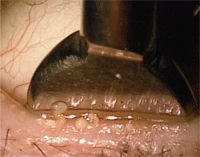Some disease processes and diagnostic procedures can present difficult challenges in coding. Coding of meibomian and ocular surface disease visits is fairly straightforward. There are few if any specialized tests that are required. The best tool in the diagnostic arsenal is an excellent case history from the patient and a thorough biomicroscopy examination.


The typical encounter for a patient who comes in with only a complaint related to the eyelids would be an ophthalmic examination code of 92002 or 92012 (new patient or established patient) or a lower level 99000 code (99202, 99203, 99212 or 99213). The code chosen depends on the level of medical history required, the level of the examination techniques used, and the level of the medical decision-making performed.
Testing such as tear film break up time (TBUT), Schirmer test, vital dye staining (lissamine green, fluorescein, rose bengal) and biomicroscopy examination cannot be charged separately because they are included in any medical management code that can be used.
In a Tight Squeeze
Recently, there have been a few journal articles about the benefits of meibomian gland expression as a treatment option performed in the office setting. At this time, there is not a specific code that can be used that properly describes this procedure. A few authors have encouraged the use of a couple of different CPT codes for this procedure.
However, because there is no CPT code that accurately describes this procedure, exercise caution if you decide to use such codes. Make sure that you meet the CPT definition and follow all CPT rules involving minor surgical procedures should you go down this path. The most frequently cited CPT codes are:
• 67700: Blepharotomy, drainage of abscess, eyelid. The physician makes an incision to drain an abscess on the eyelid.
• 67800: Excision of chalazion; single. The physician removes a cyst from the eyelid.
An alternative might be the miscellaneous eyelid procedure CPT code 67999 (unlisted procedure, eyelids), but many insurance companies require office notes to be sent in along with other requested documentation when this code is used. And this miscellaneous code may or may not be paid.
When an unlisted procedure is performed, an Advance Beneficiary Notice of Non-Coverage (ABN) or the private insurance company equivalent should be signed by the patient before the procedure, appending the surgical code with modifier -GX or -GA. In the event that the procedure is denied, the patient would be financially responsible for the procedure.

What code do you use to express glands? Photo: Mile Brujic, O.D.
The American Optometric Association Clinical Practice Guidelines recommend closely following a patient with an acute meibomian gland condition or blepharitis frequently in the first few weeks or months of diagnosis until the condition is properly controlled. Depending on the severity of the patient’s condition, the office visit frequency could be as often as twice a week until control is achieved. Once a patient’s condition is under control, follow-up visits would be at six to 12 month intervals.
Coding of the visits for treating meibomian eyelid disease is straightforward. The frequency of the visits will vary with the severity of the disease process. Treating this common disease process appropriately and aggressively will improve the patient’s satisfaction and quality of life.
Please send your comments to
CodingAbstract@gmail.com.
Clinical Coding Committee
• John Rumpakis, O.D., M.B.A.,
Clinical Coding Editor
• Joe DeLoach, O.D.
• David Mills, O.D., M.B.A.
• Laurie Sorrenson, O.D.
• Rebecca Wartman, O.D.

